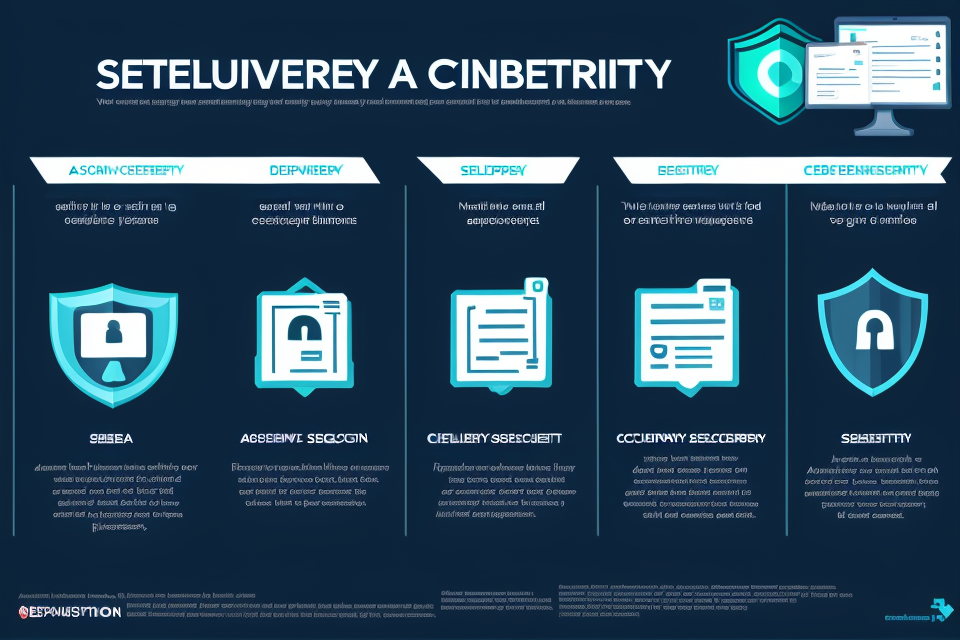
Data and cybersecurity are two terms that are often used interchangeably, but is
What is Data Security?
Definition and Importance
Data security refers to the protection of electronic and physical data from unauthorized access, use, disclosure, disruption, modification, or destruction. It involves implementing various measures and controls to ensure the confidentiality, integrity, and availability of data.
Data security is crucial because it helps organizations to protect sensitive information, such as financial data, customer data, and intellectual property, from cyber threats and other security risks. In addition, data security helps organizations to comply with legal and regulatory requirements, such as the General Data Protection Regulation (GDPR) and the Health Insurance Portability and Accountability Act (HIPAA).
Types of data security threats include:
- Cyber attacks, such as malware, ransomware, and phishing attacks
- Insider threats, such as employee negligence or malicious insiders
- Physical threats, such as theft or loss of devices or storage media
- Natural disasters, such as floods or fires
- Human errors, such as accidental data loss or exposure
Effective data security measures should be implemented to mitigate these threats and protect data from unauthorized access or misuse.
Data Security Measures
Access Control
Access control is a crucial component of data security measures. It involves restricting access to sensitive data to authorized individuals only. Access control can be implemented through various methods, such as user authentication, role-based access control, and encryption.
User authentication involves verifying the identity of users who are requesting access to sensitive data. This can be done through password-based authentication, biometric authentication, or multi-factor authentication. Role-based access control restricts access to data based on the roles of users within an organization. For example, a sales manager may have access to customer data, but a junior sales associate may not.
Encryption
Encryption is another critical measure for protecting sensitive data. It involves converting plain text data into cipher text, which is unreadable without the appropriate decryption key. Encryption can be implemented at various levels, such as file-level encryption, network-level encryption, or database-level encryption.
Encryption is particularly useful for protecting data in transit, such as when it is being transmitted over a network. This is because data can be intercepted and accessed by unauthorized parties during transmission. Encryption ensures that even if data is intercepted, it cannot be read without the appropriate decryption key.
Backup and Recovery
Backup and recovery is another important aspect of data security measures. It involves creating copies of data and storing them in a secure location. This is important in case of data loss or corruption. Backup and recovery can be implemented through various methods, such as cloud backup, external hard drive backup, or tape backup.
It is important to test backup and recovery procedures regularly to ensure that they are effective. This can involve conducting regular backups and restoring data from backups to ensure that they can be accessed and used effectively.
User Awareness and Training
User awareness and training is also an important aspect of data security measures. Users are often the weakest link in data security, as they may inadvertently expose sensitive data through their actions. User awareness and training involves educating users on the importance of data security and how to handle sensitive data appropriately.
User awareness and training can include providing users with information on phishing scams, social engineering attacks, and other common methods used by cybercriminals to gain access to sensitive data. It can also involve providing users with guidelines on how to create strong passwords, how to recognize suspicious emails, and how to handle sensitive data appropriately. Regular training and awareness programs can help ensure that users are up-to-date on the latest threats and best practices for data security.
What is Cybersecurity?
Cybersecurity is the practice of protecting computer systems, networks, and data from unauthorized access, theft, damage, or attack. It is a critical aspect of modern-day technology, given the increasing reliance on digital systems and data storage. Cybersecurity threats are constantly evolving, making it imperative to stay informed and up-to-date with the latest security measures.
Definition of Cybersecurity
Cybersecurity encompasses a range of technologies, processes, and practices designed to safeguard digital systems and data from unauthorized access, use, disclosure, disruption, modification, or destruction. It involves the use of software, hardware, and procedures to prevent cyber-attacks, protect data, and maintain the integrity of computer systems and networks.
Why Cybersecurity is Important
Cybersecurity is essential for protecting sensitive information and maintaining the integrity of digital systems. Without proper cybersecurity measures, businesses and individuals risk losing valuable data, experiencing financial losses, and suffering reputational damage. Cybersecurity threats are becoming increasingly sophisticated, making it necessary to invest in robust security measures to stay ahead of potential attacks.
Cybersecurity Measures
- Firewalls
- Types of Firewalls
- Packet Filtering Firewalls
- Stateful Inspection Firewalls
- Application-Level Firewalls
- Functions of Firewalls
- Filtering Incoming Traffic
- Blocking Outgoing Traffic
- Controlling Access to Network Resources
- Types of Firewalls
- Intrusion detection and prevention
- Types of Intrusion Detection and Prevention Systems
- Network-Based Systems
- Host-Based Systems
- Hybrid Systems
- Functions of Intrusion Detection and Prevention Systems
- Detecting Unusual Network Activity
- Blocking Malicious Traffic
- Logging Suspicious Activity
- Types of Intrusion Detection and Prevention Systems
- Vulnerability assessment and management
- Types of Vulnerability Assessment and Management Tools
- Automated Scanning Tools
- Manual Penetration Testing
- Vulnerability Management Platforms
- Functions of Vulnerability Assessment and Management Tools
- Identifying Security Weaknesses
- Prioritizing Remediation Efforts
- Monitoring for New Vulnerabilities
- Types of Vulnerability Assessment and Management Tools
- Disaster recovery and business continuity
- Types of Disaster Recovery and Business Continuity Plans
- Hot Site Backup
- Cold Site Backup
- Warm Site Backup
- Functions of Disaster Recovery and Business Continuity Plans
- Ensuring Data Availability in the Event of a Disaster
- Minimizing Downtime
- Protecting Reputation and Brand Image
- Types of Disaster Recovery and Business Continuity Plans
The Relationship Between Data Security and Cybersecurity
Overview
In today’s digital age, data security and cybersecurity are two concepts that are often used interchangeably. However, while they are related, they are not the same thing. It is important to understand the difference between the two in order to effectively protect sensitive information.
Data security refers to the protection of digital data from unauthorized access, use, disclosure, disruption, modification, or destruction. It is a subset of cybersecurity that focuses on securing the data itself, regardless of where it is stored or how it is being used. This includes measures such as encryption, access controls, and backup and recovery processes.
Cybersecurity, on the other hand, is a broader term that encompasses the protection of computer systems, networks, and data from unauthorized access, use, disclosure, disruption, modification, or destruction. It is a subset of information security that deals with the threats and attacks that can be launched against digital systems and data. This includes measures such as firewalls, intrusion detection and prevention systems, and antivirus software.
While data security is a critical component of cybersecurity, it is important to understand that cybersecurity encompasses much more than just data security. Cybersecurity also includes physical security measures, such as locks and surveillance cameras, as well as policies and procedures for incident response and disaster recovery.
In summary, while data security and cybersecurity are related, they are not the same thing. Data security is a subset of cybersecurity that focuses on securing digital data, while cybersecurity is a broader term that encompasses the protection of computer systems, networks, and data from unauthorized access, use, disclosure, disruption, modification, or destruction.
Key Differences
While data security and cybersecurity are often used interchangeably, they are not the same thing. Both disciplines are concerned with protecting sensitive information, but they have distinct focuses and approaches. Here are some key differences between data security and cybersecurity:
Focus on data vs. focus on network and system security
Data security is primarily focused on protecting the data itself, including its confidentiality, integrity, and availability. This involves measures such as encryption, access controls, and backup and recovery procedures. Data security professionals are responsible for ensuring that data is protected from unauthorized access, modification, or destruction.
Cybersecurity, on the other hand, is concerned with protecting the entire organization from digital attacks. This includes securing networks, systems, and applications, as well as the data that is stored and transmitted across them. Cybersecurity professionals are responsible for identifying and mitigating potential threats to the organization’s digital assets, such as malware, phishing attacks, and denial-of-service attacks.
Data security is concerned with data confidentiality, integrity, and availability, while cybersecurity is concerned with protecting the entire organization from digital attacks
Data security is focused on the confidentiality, integrity, and availability of data. This means ensuring that data is protected from unauthorized access, modification, or destruction, and that it is available to authorized users when needed. Data security measures may include encryption, access controls, and backup and recovery procedures.
Cybersecurity, on the other hand, is concerned with protecting the entire organization from digital attacks. This includes securing networks, systems, and applications, as well as the data that is stored and transmitted across them. Cybersecurity measures may include firewalls, intrusion detection and prevention systems, and security awareness training for employees.
In summary, while data security and cybersecurity are related, they are not the same thing. Data security is focused on protecting the data itself, while cybersecurity is concerned with protecting the entire organization from digital attacks. Understanding the differences between these two disciplines is crucial for developing effective strategies to protect sensitive information in today’s digital age.
Data Security and Cybersecurity: A Holistic Approach
Integrating Data Security and Cybersecurity
In today’s digital age, data security and cybersecurity are often used interchangeably, but they are not the same. Data security focuses on protecting the confidentiality, integrity, and availability of data, while cybersecurity is concerned with protecting computer systems, networks, and data from unauthorized access, theft, damage, or attack. Therefore, integrating data security and cybersecurity is crucial for organizations to ensure the safety of their data and systems.
Integrating data security and cybersecurity involves the following:
- Importance of integrating data security and cybersecurity
Integrating data security and cybersecurity is crucial because data is the lifeblood of modern organizations, and cyber attacks are becoming increasingly sophisticated and frequent. A comprehensive approach to data security and cybersecurity helps organizations protect their data and systems from unauthorized access, theft, damage, or attack. - Best practices for integrating data security and cybersecurity
There are several best practices for integrating data security and cybersecurity, including:- Establishing a data security and cybersecurity policy: This policy should outline the organization’s approach to data security and cybersecurity, including roles and responsibilities, procedures, and protocols.
- Implementing appropriate technical controls: Technical controls, such as firewalls, intrusion detection and prevention systems, and encryption, can help protect data and systems from unauthorized access, theft, damage, or attack.
- Providing regular training and awareness programs: Regular training and awareness programs can help employees understand the importance of data security and cybersecurity and their role in protecting the organization’s data and systems.
- Regularly reviewing and updating security measures: Organizations should regularly review and update their security measures to ensure they are effective and up-to-date with the latest threats and technologies.
- Having an incident response plan in place: An incident response plan outlines the steps the organization will take in the event of a security breach or incident, including who to notify, what to do, and how to respond.
In conclusion, integrating data security and cybersecurity is crucial for organizations to ensure the safety of their data and systems. By establishing a data security and cybersecurity policy, implementing appropriate technical controls, providing regular training and awareness programs, regularly reviewing and updating security measures, and having an incident response plan in place, organizations can better protect their data and systems from unauthorized access, theft, damage, or attack.
Balancing Data Security and Cybersecurity
Balancing the need for data security and cybersecurity
In today’s digital age, data security and cybersecurity are of paramount importance for individuals and organizations alike. Both data security and cybersecurity are critical components of a comprehensive security strategy, but they are not the same thing. While data security focuses on protecting sensitive information from unauthorized access, cybersecurity encompasses a broader range of activities aimed at safeguarding computer systems, networks, and data from digital attacks.
Factors to consider when balancing data security and cybersecurity
Balancing data security and cybersecurity can be a challenging task, especially for organizations that handle large volumes of sensitive data. Some of the factors to consider when balancing data security and cybersecurity include:
- Threat landscape: The threat landscape is constantly evolving, and organizations need to stay ahead of the curve by continuously monitoring and assessing their security posture. This requires a holistic approach that takes into account both internal and external threats.
- Data classification: Organizations need to classify their data based on its sensitivity and criticality. This helps to prioritize security measures and ensure that resources are allocated where they are most needed.
- Regulatory compliance: Regulatory compliance is a critical factor to consider when balancing data security and cybersecurity. Organizations must comply with various regulations and standards, such as the General Data Protection Regulation (GDPR) and the Payment Card Industry Data Security Standard (PCI DSS), to ensure that they are protecting sensitive data.
- User behavior: User behavior is a significant factor in data security and cybersecurity. Organizations need to educate their employees on best practices for data security and cyber hygiene, such as using strong passwords, avoiding phishing attacks, and keeping software up to date.
- Resource allocation: Organizations need to allocate resources appropriately to ensure that they are effectively balancing data security and cybersecurity. This requires a careful analysis of the risks and threats facing the organization and the allocation of resources accordingly.
In conclusion, balancing data security and cybersecurity is a critical task for organizations that handle sensitive data. By considering factors such as the threat landscape, data classification, regulatory compliance, user behavior, and resource allocation, organizations can develop a comprehensive security strategy that addresses both data security and cybersecurity.
FAQs
1. What is data security?
Data security refers to the protection of digital information from unauthorized access, use, disclosure, disruption, modification, or destruction. It encompasses a range of practices, technologies, and policies that are designed to safeguard sensitive data and prevent data breaches. Data security is critical for organizations of all sizes, as it helps to maintain the confidentiality, integrity, and availability of data.
2. What is cybersecurity?
Cybersecurity is the practice of protecting internet-connected systems, including hardware, software, and data, from attack, damage, or unauthorized access. It involves a range of technologies, practices, and policies that are designed to secure networks, devices, and data against cyber threats. Cybersecurity is essential for individuals, businesses, and governments, as it helps to protect against cybercrime, cyber espionage, and other forms of cyber attack.
3. Is data security the same as cybersecurity?
Data security and cybersecurity are related but distinct concepts. Data security is focused on the protection of digital information, while cybersecurity is focused on the protection of internet-connected systems. Data security is an important aspect of cybersecurity, as it helps to ensure the confidentiality, integrity, and availability of data. However, cybersecurity encompasses a broader range of activities, including network security, device security, and user security.
4. What are some common data security threats?
Data security threats can take many forms, including malware, phishing attacks, ransomware, and data breaches. Malware is a type of software that is designed to damage or disrupt computer systems. Phishing attacks involve the use of fake emails or websites to trick people into revealing sensitive information. Ransomware is a type of malware that encrypts data and demands a ransom in exchange for the decryption key. Data breaches occur when unauthorized individuals gain access to sensitive data.
5. What are some common cybersecurity threats?
Cybersecurity threats can include malware, phishing attacks, ransomware, and cyber espionage. Malware is a type of software that is designed to damage or disrupt computer systems. Phishing attacks involve the use of fake emails or websites to trick people into revealing sensitive information. Ransomware is a type of malware that encrypts data and demands a ransom in exchange for the decryption key. Cyber espionage involves the unauthorized access of data for the purpose of gaining a competitive advantage or stealing intellectual property.
6. How can I protect my data and my organization from cyber threats?
There are many steps you can take to protect your data and your organization from cyber threats. These include using strong passwords, keeping software up to date, using antivirus software, and implementing firewalls. You should also be aware of phishing attacks and be cautious when clicking on links or opening attachments from unknown sources. Additionally, it is important to have a data backup plan in place in case of a data breach.
7. What are some best practices for data security?
Some best practices for data security include using encryption to protect sensitive data, implementing access controls to limit who can access data, and regularly reviewing and updating data security policies and procedures. It is also important to provide training and education to employees on data security best practices, and to regularly test and assess the effectiveness of data security measures.
8. What are some best practices for cybersecurity?
Some best practices for cybersecurity include using firewalls and antivirus software to protect against cyber threats, using strong passwords and multi-factor authentication to secure accounts, and regularly updating software and security patches. It is also important to have a cybersecurity incident response plan in place in case of a cyber attack, and to provide training and education to employees on cybersecurity best practices.


